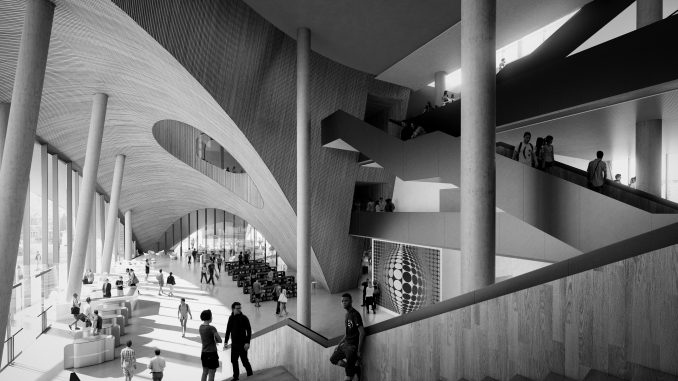
Joe Lucia understands why some may question why Temple is building a new library.
“A lot of people ask you in a digital world, why are you building a library?” said Lucia, dean of libraries at Temple. “It’s expensive … people wonder why you build a building like this when there are other issues on campus.”
Lucia is referring to Temple’s new library, a 210,000 square-foot facility estimated to be completed by mid- to late 2018. The project will cost $190 million, $140 million of which will come from state funding.
Last week, Snøhetta—the architecture firm tasked with designing the library—released more renderings of the facility, further showing the interior of the building.
Nathan McRae, the project manager from Snøhetta, said University Architect Margaret Carney had the “vision” for the library, and that the building shows Temple is willing to further invest it its infrastructure.
“More and more people are using notable and distinctive architecture to help with recruitment and make the statement that they’re willing to invest in education,” McRae said.
Carney said she had a lot of help from other administrators and Snøhetta in designing and planning the building, and that the library represents the changing environment of higher education.
“It’s just so different than it was 20 years ago,” she said. “A library is that one place where that group work is done … they want to be together and have the technology at their fingertips.”
Plans for the new library include variation in small study rooms and large collaborative spaces, which includes a large study area open 24 hours a day, with an adjacent cafe and event space nearby, Lucia said.
Lucia said the study rooms—around 50 of varying sizes—will be able to be reserved by students through a mobile app. The library will also feature “immersive visualization spaces:” rooms with high-tech display screens to do work involving large-scale research and work with manipulating data, he added.
Carney said the importance of these study spaces is significant because it will provide university commuters with more options to meet and collaborate.
Along with the spacing, another aspect of the library is wooden domes that help define the entry to the new building, McRae said.
“They’re pretty unique in their geography and form,” McRae said. “The domes are the primary and unique device of the building.”
Lucia said another distinctive part of the building will be the robotic arm retrieval system—a device that will take books from 150,000 square feet and reduce their footprint to a three-story space of 15,000 square feet.
“We’re not in a moment at Temple where we’re ready to get rid of our print collection,” he said of the new technology’s impact.
Lucia said plans are still being formed for how the university will use Paley Library once the new library is completed. The building, after renovations, could be used for more class or study space, he said.
Besides the new architecture, the renderings distinctly show how light will be important to the new structure. Lucia said this factor shows how libraries are evolving and how the new building will be different from Paley.
“I think the place of light in a library experience is very important,” he said. “Paley was kind of about making a closed box where you interact with the books on shelves.”
Steve Bohnel and Lian Parsons can be reached at news@temple-news.com or on Twitter @TheTempleNews
Listen online to “Beyond the Lede” with WHIP—Temple’s student radio—and The Temple News’ reporters for more information on this story and more.


Be the first to comment